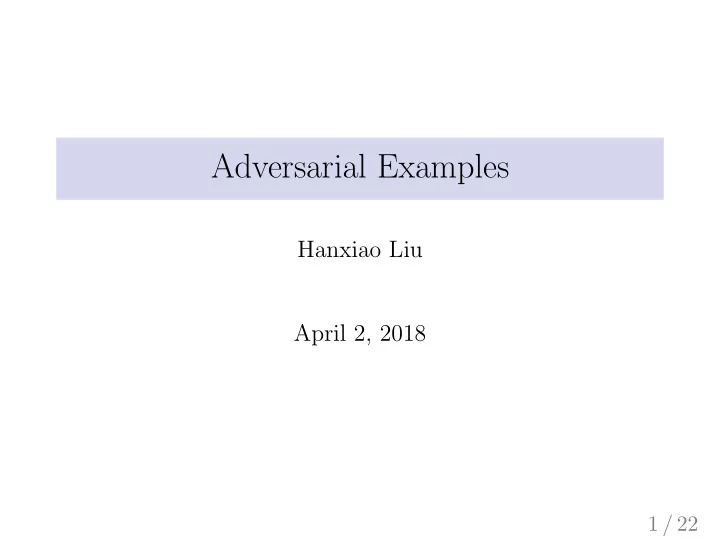

Adversarial Examples Hanxiao Liu April 2, 2018 1 / 22
Adversarial Examples “Inputs to ML models that an attacker has intentionally designed to cause the model to make a mistake” 1 Why this is interesting: ◮ Safety. ◮ Interpretability. ◮ Generalization. 1 https://blog.openai.com/adversarial-example-research/ 2 / 22
Adversarial Examples Fooling GoogLeNet (Inception) on ImageNet. 3 / 22
Adversarial Examples Fooling a linear model (logistic regression) on ImageNet. Figure : Before: 8.3% Goldfish; After: 12.5% Daisy. 4 / 22
Adversarial Examples in Language Understanding [Jia and Liang, 2017] Figure : Fooling BiDAF on SQuAD. 5 / 22
Adversarial Examples in the Physical World [Kurakin et al., 2016] Attaching a mask over the phone camera: https://www.youtube.com/watch?v=piYnd_wYlT8 6 / 22
Adversarial Examples in the Physical World [Athalye et al., 2018] Adversarial example using 3D-printing . . . https://www.youtube.com/watch?v=zQ_uMenoBCk 7 / 22
Autonomous Vehicles [Evtimov et al., 2017] Figure : Before: Stop sign; After: 45 mph sign [Lu et al., 2017] argues existing systems are robust: ◮ A moving camera is able to view objects from different distances and different angles. Specialized attacks for object detection systems? 8 / 22
Transferability Adversarial examples are transferable across ML models [Papernot et al., 2017]. 9 / 22
Creating Adversarial Examples Simple approach: Fast Gradient Sign Method (FGSM) [Goodfellow et al., 2014] Other techniques: Iterative FGSM [Kurakin et al., 2016], L-BFGS [Szegedy et al., 2013], . . . 10 / 22
Creating Adversarial Examples One Pixel Attack [Su et al., 2017] max f adv ( x + m ) s . t . � m � 0 ≤ 1 (1) m 11 / 22
Defense ◮ Data Augmentation (e.g., dropout, cutout, mixup). ◮ Adversarial Training. ◮ Generate adversarial examples and include them as part of the training data. ◮ Distillation/Smoothing. 12 / 22
Defense Hiding information (e.g. gradient) from the attackers? Black box attack [Papernot et al., 2017] ◮ Train a “substitute model”, compute adversarial examples there and transfer them to the target model. 13 / 22
Why ML models are prone to adversary? Conjecture 1: Overfitting. ◮ Nature images are within the correct regions but are also sufficiently close to the decision boundary. (Goodfellow 2016) 14 / 22
Why ML models are prone to adversary? Conjecture 2: Excessive Linearity. ◮ Decision boundary for most ML models are (near-)piecewise linear. ◮ In high dimension, w ⊤ x is prone to perturbation. (Goodfellow 2016) 15 / 22
Why ML models are prone to adversary? Empirical observation: nearly linear responses over ǫ . Figure : How ǫ affects the softmax logits on CIFAR-10. [Goodfellow et al., 2014] 16 / 22
Interpretability Why this is relevant? Figure : ∇ x f ( x ) reveals the salient features of x . [Simonyan et al., 2013] 17 / 22
Interpretability via Influence Functions [Koh and Liang, 2017]: Identifying training points most responsible for a given prediction. ◮ How would the model’s predictions change if we did not have this training point? 18 / 22
Interpretability via Influence Functions [Koh and Liang, 2017] The learned influence function allows us to create adversarial training (not testing!) examples. 19 / 22
Reference I Athalye, A., Engstrom, L., Ilyas, A., and Kwok, K. (2018). Synthesizing robust adversarial examples. Evtimov, I., Eykholt, K., Fernandes, E., Kohno, T., Li, B., Prakash, A., Rahmati, A., and Song, D. (2017). Robust physical-world attacks on deep learning models. arXiv preprint arXiv:1707.08945 , 1. Goodfellow, I. J., Shlens, J., and Szegedy, C. (2014). Explaining and harnessing adversarial examples. arXiv preprint arXiv:1412.6572 . Jia, R. and Liang, P. (2017). Adversarial examples for evaluating reading comprehension systems. arXiv preprint arXiv:1707.07328 . Koh, P. W. and Liang, P. (2017). Understanding black-box predictions via influence functions. arXiv preprint arXiv:1703.04730 . Kurakin, A., Goodfellow, I., and Bengio, S. (2016). Adversarial examples in the physical world. arXiv preprint arXiv:1607.02533 . 20 / 22
Reference II Lu, J., Sibai, H., Fabry, E., and Forsyth, D. (2017). No need to worry about adversarial examples in object detection in autonomous vehicles. arXiv preprint arXiv:1707.03501 . Papernot, N., McDaniel, P., Goodfellow, I., Jha, S., Celik, Z. B., and Swami, A. (2017). Practical black-box attacks against machine learning. In Proceedings of the 2017 ACM on Asia Conference on Computer and Communications Security , pages 506–519. ACM. Simonyan, K., Vedaldi, A., and Zisserman, A. (2013). Deep inside convolutional networks: Visualising image classification models and saliency maps. arXiv preprint arXiv:1312.6034 . Su, J., Vargas, D. V., and Kouichi, S. (2017). One pixel attack for fooling deep neural networks. arXiv preprint arXiv:1710.08864 . 21 / 22
Reference III Szegedy, C., Zaremba, W., Sutskever, I., Bruna, J., Erhan, D., Goodfellow, I., and Fergus, R. (2013). Intriguing properties of neural networks. arXiv preprint arXiv:1312.6199 . 22 / 22
Recommend
More recommend